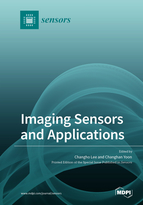Imaging Sensors and Applications
A special issue of Sensors (ISSN 1424-8220). This special issue belongs to the section "Physical Sensors".
Deadline for manuscript submissions: closed (10 February 2021) | Viewed by 83161
Special Issue Editors
Interests: biomedical optical imaging; molecular imaging; quantitative analysis and signal processing
Special Issues, Collections and Topics in MDPI journals
2. Department of Nanoscience and Engineering, Inje University, Gimhae 50834, Republic of Korea
Interests: ultrasound imaging; molecular imaging
Special Issues, Collections and Topics in MDPI journals
Special Issue Information
Dear Colleagues,
In past decades, various sensor technologies have been used in all areas of our lives, thus improving our quality of life. In particular, imaging sensors have been widely applied in the development of various imaging approaches such as optical imaging, ultrasound imaging, X-ray imaging, and nuclear imaging, and contributed to achieve high sensitivity, miniaturization, and real-time imaging. These advanced image sensing technologies play an important role not only in the medical field but also in the industrial field.
This Special Issue covers broad topics on imaging sensors and applications. The scope range of imaging sensors can be extended to novel imaging sensors and diverse imaging systems, including hardware and software advancements. Additionally, biomedical and nondestructive sensing applications are welcome. The Issue will publish full research papers, communications, and reviews.
Prof. Dr. Changho Lee
Prof. Dr. Changhan Yoon
Guest Editors
Manuscript Submission Information
Manuscripts should be submitted online at www.mdpi.com by registering and logging in to this website. Once you are registered, click here to go to the submission form. Manuscripts can be submitted until the deadline. All submissions that pass pre-check are peer-reviewed. Accepted papers will be published continuously in the journal (as soon as accepted) and will be listed together on the special issue website. Research articles, review articles as well as short communications are invited. For planned papers, a title and short abstract (about 100 words) can be sent to the Editorial Office for announcement on this website.
Submitted manuscripts should not have been published previously, nor be under consideration for publication elsewhere (except conference proceedings papers). All manuscripts are thoroughly refereed through a single-blind peer-review process. A guide for authors and other relevant information for submission of manuscripts is available on the Instructions for Authors page. Sensors is an international peer-reviewed open access semimonthly journal published by MDPI.
Please visit the Instructions for Authors page before submitting a manuscript. The Article Processing Charge (APC) for publication in this open access journal is 2600 CHF (Swiss Francs). Submitted papers should be well formatted and use good English. Authors may use MDPI's English editing service prior to publication or during author revisions.
Keywords
- novel imaging sensors
- optical imaging
- ultrasound/acoustic imaging
- optoacoustic/phoacoustic imaging
- advanced imaging sensing techniques
- imaging and signal processing algorithm
- biomedical sensing application
- nondestructive sensing application








